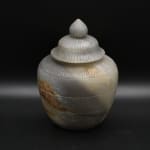Mughal Agate Vessel, 1600-1800 CE
height 7 1/8 in
Further images
Provenance
This elegant Mughal vessel is rendered out of the semi-precious Agate stone, and is a beautiful example of the famed Mughal tradition of hardstone carving. The vessel and lid feature a gradient of grey, ochre, cream, and brown hues, reflecting the natural and unique colour and lustre of agate. Although a long-standing tradition in carving, hardstone carving reached its zenith during Shah Jahan’s reign over Mughal India in the 17th century CE. Jahan, famed for his construction of the Taj Mahal, championed the practice of intricate hardstone carving, especially for architectural inlays. The hardstones used were sourced from around the world, including yellow amber from Burma, lapis-lazuli from Afghanistan, and carnelian, agate, amethyst, jade, etc. from the Indian subcontinent. Hardstone carving is a labour intensive process, due to the crystalline structure of the mineral, which does not usually allow for detailed carving. (LI.3196 FA).









